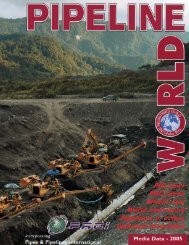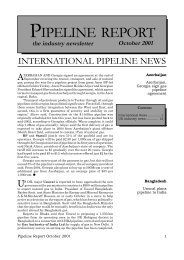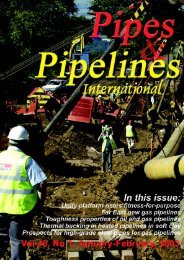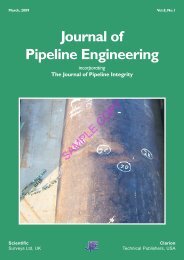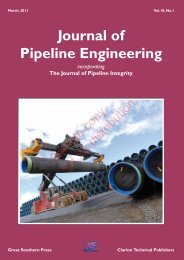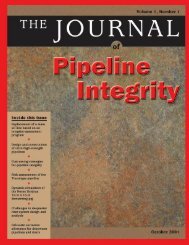JPE - Sept09 - cover2-4.pmd - Pipes & Pipelines International ...
JPE - Sept09 - cover2-4.pmd - Pipes & Pipelines International ...
JPE - Sept09 - cover2-4.pmd - Pipes & Pipelines International ...
Create successful ePaper yourself
Turn your PDF publications into a flip-book with our unique Google optimized e-Paper software.
182<br />
Conclusion<br />
Our presented non-linear elastic-plastic fracture mechanics<br />
analysis of the fifth spill incident indicates that the high<br />
toughness of both the pipe material and the weld material<br />
necessitated the combination of extremely high axial loads<br />
(which exceeded the uniaxial yield strength of the material)<br />
and a biaxial stress state to propagate defects at the<br />
circumferential girth welds. The biaxial stress state, caused<br />
by the internal pressure, essentially increases the load<br />
needed to cause yielding in the pipe and can allow ductile<br />
tearing to occur in the girth welds before the load reaches<br />
this higher yield point for biaxial stress. A substantial axial<br />
load can cause ductile tearing of defects that are considered<br />
allowable by API 1104, since girth welds may be code<br />
compliant, but may still contain allowable deviations from<br />
the ideal condition allowed in the standard. These minor<br />
defects will ultimately provide the stress risers to initiate<br />
cracks as high loads arise. Although the exact propagation<br />
rate was not determined, it seems likely that this tearing<br />
could occur over a short time: this limits the ability of (ILI)<br />
tools in identifying these defects in a timely fashion.<br />
Currently only an ultrasound ILI with a modified sensor<br />
arrangement would reliably detect circumferential cracks<br />
within an actionable timeframe to safeguard the pipeline<br />
against potential geotechnical hazards. However, at present,<br />
insufficient evaluation has been conducted to establish the<br />
relationship between the onset of tearing and the shape,<br />
size, and orientation of welding defects. The timescales of<br />
the ductile tearing have also not been established sufficiently<br />
to rely upon periodic inspection. Hence, detailed<br />
geotechnical studies prior to construction, careful<br />
monitoring of the pipeline’s RoW, and geotechnical risk<br />
assessments appear currently to be the most comprehensive<br />
way to safeguard the integrity of the pipeline. Constructing<br />
the necessary geotechnical stabilization measures can<br />
typically mitigate geotechnical hazards.<br />
When designing pipeline systems, particularly for use in<br />
susceptible geological environments, it is important to<br />
recognize that axial loads generated from soil movement<br />
The Journal of Pipeline Engineering<br />
can be high enough to propagate relatively-small<br />
circumferential flaws and cause failure. Currently-available<br />
commercial pipeline inspection methods do not appear to<br />
provide a suitable means of detecting such flaws and<br />
guarding against failure due to propagation of these<br />
relatively-small flaws. Therefore, in susceptible geologic<br />
environments, extra attention must be given during the<br />
design phase to specifically include suitable and conservative<br />
assumptions of the external loading.<br />
References<br />
1. EGIG, 2005. Report 1970-2004. Gas pipeline incidents.<br />
6th Report of the European Gas Pipeline Incident Data<br />
Group, Doc. Number EGIG 05.R.0002, December.<br />
2. PRCI, 2004. Guidelines for the seismic design and assessment<br />
of natural gas and liquid hydrocarbon pipelines. Catalog No.<br />
L51927, October.<br />
3. Exponent Failure Analysis, 2007. Report: Integrity analysis<br />
of the Camisea transportation system, Peru. Submitted to<br />
the Inter-American Development Bank, June.<br />
4. A.P.S. Selvadurai, J. J. Lee, R.A.A. Todeschini, and H.F.<br />
Somes, 1983. Lateral soil resistance in soil-pipe interaction.<br />
Proc. Conf. <strong>Pipelines</strong> in adverse environments 11, San<br />
Diego, California, November.<br />
5. M. Sweeney, A. H. Gasca, M. G. Lopez, and A. C. Palmer.<br />
<strong>Pipelines</strong> and landslides in rugged terrain: a database, historic<br />
risks and pipeline vulnerability.<br />
6. Germanischer Lloyd, 2007. Report: Auditoria integral de<br />
los sistemas de transporte de gas natural y liquidos de gas<br />
natural del proyecto Camisea. Final audit report of the<br />
Ministerio de Energia y Minas del Peru, No. GLP/GLM/<br />
MEMP/726-07, October.<br />
7. Mauricio Carvalho Silva, Eduardo Hippert Jr., and Claudio<br />
Ruggieri, 2005. Experimental investigation of ductile tearing<br />
properties for API X70 and X80 pipeline steels. Proc. PVP2005<br />
2005 ASME Pressure vessels and piping division conference,<br />
July 17-21, Denver, CO, USA.<br />
8. C. Ruggieri and E. Hippert Jr., 2002. Cell model predictions<br />
of ductile fracture in damaged pipelines. Fatigue and Fracture<br />
Mechanics: 33rd Volume, ASTM STP 1417, Walter G. Reuter<br />
and Robert S. Piascik, Eds, ASTM <strong>International</strong>.<br />
Sample issue



